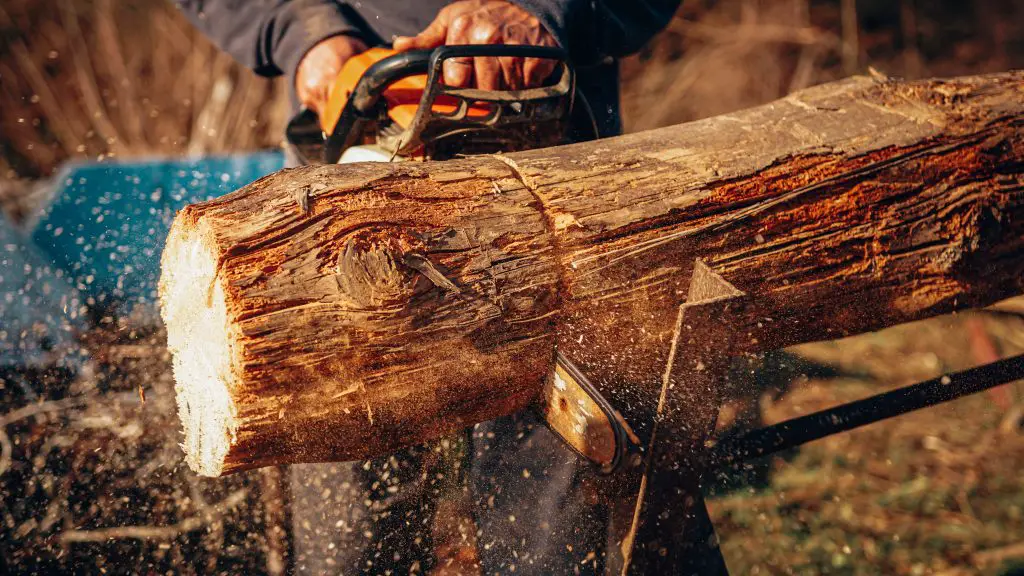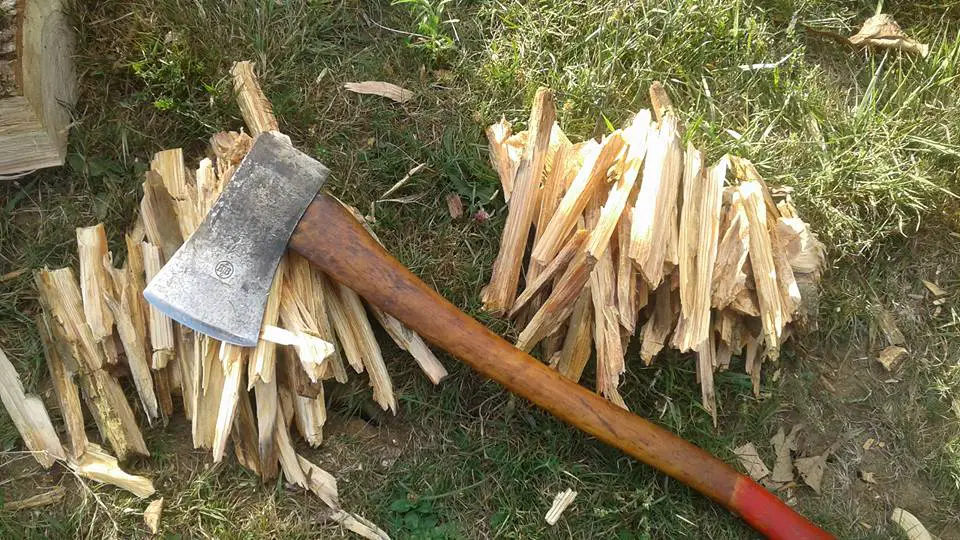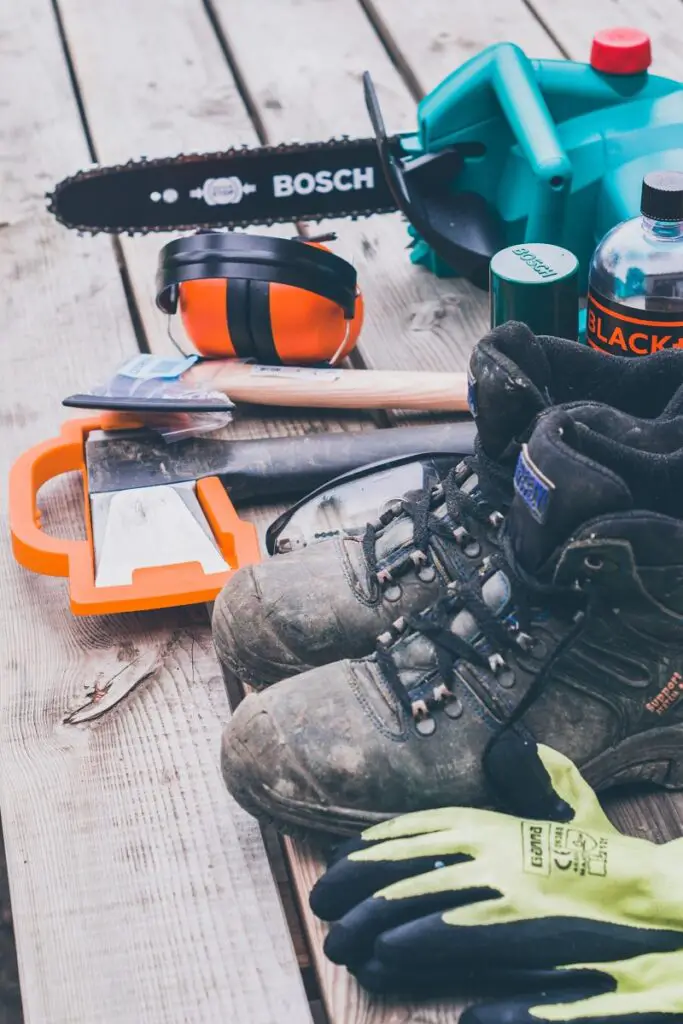When splitting wood, an axe is more suitable for precision and control, while a chainsaw is ideal for quickly cutting through large volumes. Choose an axe for manual efficiency and a chainsaw for speed and power, keeping safety and personal preferences in mind.
It’s often easier and quicker to take down a large tree with a chainsaw than an axe. However, an axe can make quick work of branches and small limbs.
Chainsaws and axes are suited for different tasks. Here is a closer look at comparing axe vs chainsaw.
Table of Contents
Chainsaw Benefits
A chainsaw is a powered cutting tool with a chain that moves around the edge of a long flat blade. The chain contains teeth that cut through wood.
Here are some of the situations where I may use a chainsaw instead of an axe:
- Capable of cutting through larger trees
- Requires less physical effort
- Cuts faster compared to using a saw
- Safer and easier for limbing and bucking
A chainsaw can cut through larger, thicker trees. I wouldn’t want to try chopping down a tree measuring several feet in diameter when I could easily complete the job with a chainsaw.
You do not need to cut the tree manually, so using a chainsaw is less tiring on the body. You need to use some muscle to maintain control of the chainsaw and handle the vibrations from the tool. However, it still requires less physical effort compared to swinging an axe.
Cutting a tree with a chainsaw also takes less time. A chainsaw may cut through a tree in a fraction of the time it would take using an axe.
A chainsaw is the preferred tool for limbing and bucking a downed tree. Limbing refers to the removal of branches from the tree.
Bucking involves cutting the downed tree into more manageable sections, which is easier and safer with a chainsaw. I then switch to an axe to start splitting the wood.

Axe Benefits
An axe is a long-handled tool with a sharp, flat blade. Axes also come in many sizes, lengths, and styles.
Felling axes are designed specifically for cutting down trees. Splitting axes are used to split wood.
A hatchet is a smaller axe used for light chopping tasks. I’d likely use a hatchet for cutting limbs and trees measuring three inches or less in diameter.
The main benefits of using an axe over a chainsaw include:
- Less expensive
- No noise from a motor
- Does not require gas or oil
- Safer to operate
- Requires less maintenance
- Easier to transport
An axe costs less compared to a decent chainsaw. I can find a quality steel axe for $20 to $50, while a 14-inch chainsaw may cost $150 to $250. Heavy-duty chainsaws with longer blades can cost hundreds of dollars.
An axe also produces less noise. The only noise is the sound of the axe cutting through the air and thwacking the wood.
Chainsaws are noisy machines. A gas chainsaw can produce 110 to 120 decibels (dB) of noise. The typical gas lawnmower only produces about 85 dB of noise.
An axe also eliminates the need for gas, oil, or electricity. You can use an axe anywhere without worrying about refilling the gas tank or recharging a rechargeable battery.
An axe is safer to use compared to a chainsaw. Chainsaws include safety features but are responsible for tens of thousands of injuries annually. Kickback can occur within a fraction of a second and cause severe injury or death.
An axe requires less maintenance compared to a chainsaw. You need to frequently check the oil in a chainsaw. Chainsaw maintenance also involves cleaning and lubricating the chain and bar.
Axe maintenance mostly involves cleaning the blade and occasionally sharpening it. You may occasionally need to replace the handle, but this still involves less work than maintaining a chainsaw.
An axe is easier to transport and carry. Chainsaws are cumbersome and awkward to carry. They also take up more space in your vehicle, garage, or shed.

Best for Splitting Wood
An axe is often safer and more efficient when splitting logs into firewood. A maul is a type of axe designed specifically for splitting wood.
Using a chainsaw requires you to work near the ground. Hitting a rock or solid earth with a chainsaw can increase the risk of kickback and other chainsaw mishaps.
I typically start with a chainsaw when taking down a large tree. I then use the chainsaw to cut the tree into smaller sections and remove major limbs. An axe is then used to split the wood or remove smaller limbs and branches.
Always ensure no one is standing near when you are ready to split wood. Stand with your legs slightly apart and pull the axe over your head. Swing the axe back over your head and down onto the log to split it.

Best for Felling Trees
A chainsaw saves time when felling large trees. A tree measuring three feet or more in diameter would require extraneous effort to take down with an axe. A chainsaw can complete the task in much less time.
Yet, you can also use an axe for felling trees. Felling axes are large axes with long handles designed specifically for cutting down trees.
Always start by cutting a notch in the direction you want the tree to fall. The notch creates a pivot point, directing the tree as it falls.
A second notch is placed on the opposite side of the tree. The second notch is added about a foot higher than the opposite.
The tree will eventually fall as you deepen the original notch. Listen for any warning signs that the tree is about to fall. This may include cracking or swaying.
Best for Safety
An axe is a safer tool compared to a chainsaw. Chainsaws are powered by a motor and capable of tearing through clothing, flesh, and bone.
According to the CDC, chainsaws are responsible for over 36,000 injuries and fatalities each year. An axe can still cause injury but is easier to control. When swinging an axe, you do not need to worry about kickback or pullback.
In the end, axes and chainsaws are useful tools that should be used for different tasks. I use a chainsaw for felling trees and an axe for splitting wood.
